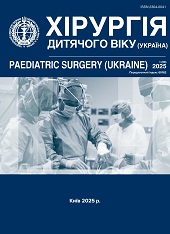The level of pain sensitivity in people with different body weight: does it have an impact on surgical operations?
DOI:
https://doi.org/10.15574/PS.2025.1(86).1114Keywords:
obesity, threshold of pain sensitivity, pain, analgesia, postoperative pain reliefAbstract
The aim: to determine the level of pain sensitivity in people with different body weight using our own improved algometer.
Materials and methods. The study involved 227 healthy people (110 men and 117 women) aged 19 to 78 years. The Group I consisted of 101 people with a body mass index (BMI) from 18.5 to <25.0. The Group II included 91 people with overweight and grade 1 obesity (BMI 25.0 to 35.0). The Group III included 36 patients with grade 2 (35.0 to <40.0) and grade 3 obesity (>40.0). The level of pain sensitivity was measured using a special original device.
Results. People in the Group I did not feel pain when pressing on the needle with a force of 13.3±2.6 g, the Group II - with a force of 20.5±4.0 g, and participants from the Group III - 29.8±8.2 g. The feeling of moderate pain was observed at the level of 36.6±3.4 g in the Group I, at the level of 51.7±4.0 g and 59.0±8.9 g in the Groups II and III, respectively. The severe pain in the Group I was recorded at 64.1±5.7 g; in the Group II - at 89.8±6.7 g; and in the Group III - at 101.3±13.0 g.
Conclusions. With increasing body weight and obesity, the threshold of pain sensitivity increases, i.e., with increasing obesity, people are more resistant to mechanical pain stimulation. Obese people are 1.5-2 times more resistant to mild, moderate, and severe mechanical stimulation than people with normal body weight. Reduced pain sensation in obese people may be one of the reasons for the masked development of purulent inflammatory processes of soft tissues, acute inflammatory, oncological, and destructive processes of internal organs.
The study was performed in accordance with the principles of the Declaration of Helsinki. The study protocol was approved by the Local Ethics Committee of the university. The informed consent was obtained from the patients.
The authors declare no conflict of interest.
References
Basem JI, White RS, Chen SA, Mauer E, Steinkamp ML et al. (2021). The effect of obesity on pain severity and pain interference. Pain management. 11(5): 571-581. https://doi.org/10.2217/pmt-2020-0089; PMid:34102863 PMCid:PMC9008601
CDC. Defining Adult Overweight & Obesity. URL: https://www.cdc.gov/obesity/adult/defining.html
Chin SH, Huang WL, Akter S, Binks M. (2020). Obesity and pain: a systematic review. International journal of obesity. 44(5): 969-979. https://doi.org/10.1038/s41366-019-0505-y; PMid:31848456
Emerson NM, Nahman-Averbuch H, Peugh JL, Coghill RC. (2021). Pain sensitivity does not differ between obese and healthy weight individuals. Pain reports. 6(3): e942. https://doi.org/10.1097/PR9.0000000000000942; PMid:34514273 PMCid:PMC8423383
Janke EA, Collins A, Kozak AT. (2007). Overview of the relationship between pain and obesity: What do we know? Where do we go next? Journal of rehabilitation research and development. 44(2): 245-262. https://doi.org/10.1682/JRRD.2006.06.0060; PMid:17551876
Majchrzak M, Brzecka A, Daroszewski C, Błasiak P, Rzechonek A, Tarasov VV et al. (2019). Increased Pain Sensitivity in Obese Patients After Lung Cancer Surgery. Frontiers in pharmacology. 10: 626. https://doi.org/10.3389/fphar.2019.00626; PMid:31258474 PMCid:PMC6586739
Khimich S. (1997). Level of sensitivity of pain in patients with obesity. Acta chirurgica Hungarica. 36(1-4): 166-167.
Peltonen M, Lindroos AK, Torgerson JS. (2003). Musculoskeletal pain in the obese: a comparison with a general population and long-term changes after conventional and surgical obesity treatment. Pain. 104(3): 549-557. https://doi.org/10.1016/S0304-3959(03)00091-5; PMid:12927627
Price RC, Asenjo JF, Christou NV, Backman SB, Schweinhardt P. (2013). The role of excess subcutaneous fat in pain and sensory sensitivity in obesity. European journal of pain (London, England). 17(9): 1316-1326. https://doi.org/10.1002/j.1532-2149.2013.00315.x; PMid:23576531
Torensma B, Oudejans L, van Velzen M, Swank D, Niesters M, Dahan A. (2017). Pain sensitivity and pain scoring in patients with morbid obesity. Surgery for obesity and related diseases : official journal of the American Society for Bariatric Surgery. 13(5): 788-795. https://doi.org/10.1016/j.soard.2017.01.015; PMid:28216116
Downloads
Published
Issue
Section
License
Copyright (c) 2025 Paediatric Surgery (Ukraine)

This work is licensed under a Creative Commons Attribution-NonCommercial 4.0 International License.
The policy of the Journal “PAEDIATRIC SURGERY. UKRAINE” is compatible with the vast majority of funders' of open access and self-archiving policies. The journal provides immediate open access route being convinced that everyone – not only scientists - can benefit from research results, and publishes articles exclusively under open access distribution, with a Creative Commons Attribution-Noncommercial 4.0 international license(СС BY-NC).
Authors transfer the copyright to the Journal “PAEDIATRIC SURGERY.UKRAINE” when the manuscript is accepted for publication. Authors declare that this manuscript has not been published nor is under simultaneous consideration for publication elsewhere. After publication, the articles become freely available on-line to the public.
Readers have the right to use, distribute, and reproduce articles in any medium, provided the articles and the journal are properly cited.
The use of published materials for commercial purposes is strongly prohibited.

